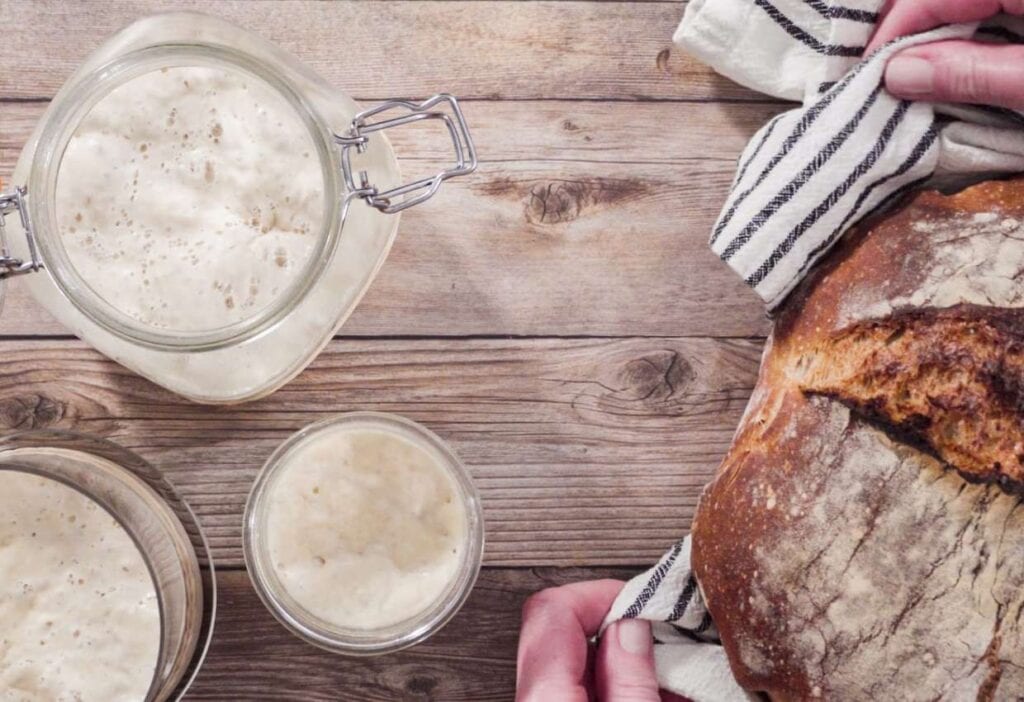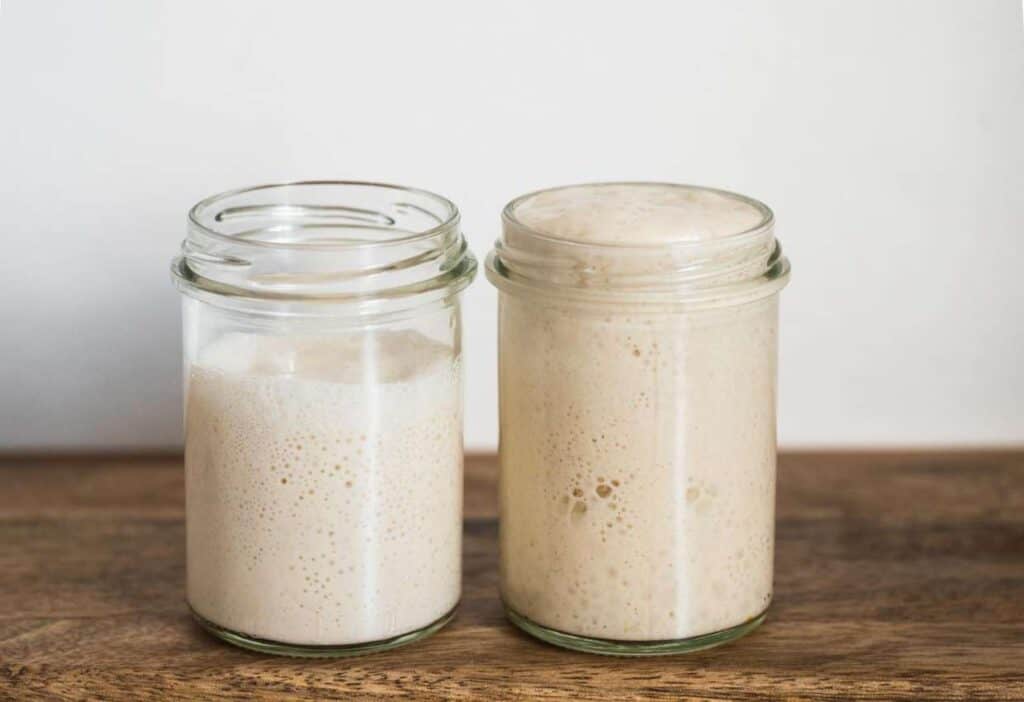There’s nothing quite like a fresh loaf of sourdough bread. And while all things sourdough have led to an explosion in storebought sourdough starters, they aren’t necessary. Making a homemade sourdough starter without yeast is simple. Here’s how.

There are many great sourdough recipes to enjoy. Luckily, making your own sourdough starter is so easy.
Why make your own sourdough starter
Starting sourdough is the simple process of making wild yeast by fermenting flour and water. When you make your own starter, you know the exact ingredients.
You won’t need to worry about unwanted chemicals or preservatives. Sourdough starter lets you make homebaked bread without depending on commercial yeast for every loaf.
Now, maybe you’ve already experimented with fermenting vegetables or other foods. Or perhaps you’ve stocked your pantry shelves with long-shelf-life foods because you want to become more self-reliant.
If so, making a homemade sourdough starter without yeast is a great project. This homemade recipe gives you wonderful satisfaction.
“My sourdough starter was doing really poorly for a while. It wasn’t bubbly; it formed a layer of hooch on top within hours and made flatbread. I accidentally bought a different brand of flour than usual and thought nothing of it, but as soon as I started using it, my starter instantly became healthy again. Pay attention to the protein content of your flour.”
— Susannah Brinkley Henry, Feast + West
Sourdough starter supplies

Here’s what you’ll need to make your sourdough starter from scratch. It’s a very short list.
- Unbleached all-purpose flour.
- Water and preferably non-chlorinated fresh water.
- A large mason jar or clean glass container with a lid.
Pretty simple. Remember, you don’t need any expensive sourdough baking equipment or supplies you may see online.
“When you work with a sourdough starter and feed it, weigh the water and flour rather than using measuring cups. The humidity in your house and how much you pack it into your measuring cup really affects the results, and weighing both makes it far more accurate.”
— Michelle Price, Honest and Truly
FDL’S 75 Best Bites

Our cookbook with 75 tasty recipes will be your go-to kitchen companion for easy dinners with ad-free recipes right at your fingertips. Crafted by experienced chefs and recipe developers, this collection offers a treasure trove of tried-and-true dishes that make mealtime a breeze.
Get the Recipe: FDL’S 75 Best Bites
Old-fashioned sourdough starter
Making a sourdough starter is easy, even for beginner bakers. After all, this is what the pioneers made and carried across the country 200 years ago.
However, monitoring and feeding the starter takes a little more skill. Above all, it takes time.
Day 1
Combine half a cup of water and a quarter cup of unbleached all-purpose flour in your glass jar on the first day. Take note — the mixture will be thick. Mix the flour and water using a wooden spoon or rubber spatula.
Day 2
Don’t do anything. Just admire your handiwork.
Day 3
On day three, you should notice some dark liquid floating on top. This is known as the hooch.
Hooch smells like stinky socks, and that’s perfectly fine. This is the mixture telling you it is ready to be fed.
To feed your starter, first scoop out half of the mixture. Either throw it away or use it in your favorite sourdough discard recipes. Then stir in another half a cup of flour and a quarter cup of water.
Sourdough discard gives baked goods an exceptionally unique and tangy flavor. Discard gets added as-is without waiting for it to rise. Use it for waffles, pancakes, scones or sourdough discard muffins.
Days 4 through 7
Every day from day four to seven, repeat that feeding process. Scoop out half the mixture and add another half cup of flour and a quarter cup of water.
You may have to do this for up to 14 days, depending on when the starter is ready. And this depends on various conditions, including the wild yeast spores in your region and your home’s temperature.
Day 7 or 8
Your homemade starter should be ready by day seven or eight. It will be full of bubbles and double in size, and it should look fluffy.
If your homemade sourdough starter is NOT ready, don’t panic. Sometimes, it just takes a little longer. Once the starter has reached the ready stage, it’s time to transfer it to a fresh jar.
How to store your sourdough starter

Leave it on the counter if you plan to use your starter in recipes twice a week or more. And remember to continue to discard half the starter and feed it daily.
On the other hand, if you plan to do a little Saturday baking store, keep your sourdough in the fridge and feed it weekly. When ready to use it, remove it from the fridge the night before baking your favorite sourdough bread recipes.
Remember to feed it while it’s at room temperature. You could also learn how to make dehydrated sourdough starter. That way, you can save it for the long term.
Homemade starters can last for years
A good homemade starter can last years when stored correctly and fed regularly. Or decades. Literally.
Make sourdough starter with whole wheat flour
For a change, substitute whole wheat or rye flour for all-purpose flour. You can also combine kinds of wheat.
Start your sourdough with whole wheat flour at the very beginning. Then, alternate feeding it with all-purpose flour every other day for a rich, pleasant flavor. Try this Dutch oven artisan sourdough bread recipe for a rustic loaf.
When the starter won’t bubble
The most common reason sourdough starter doesn’t bubble is a cold temperature. Move the glass jar to a warmer location, like a cold oven or beside a wood stove.
“If your sourdough starter isn’t rising as you expect, here’s a cheat hack: add a quarter teaspoon of yeast and a quarter teaspoon of sugar to jump-start it. While this might offend purists, it has helped our dough rise like we wanted it to, and it never affected the taste when we used it in our sourdough
— Leah Ingram, Bagels and Lasagnapizza dough recipe.”
Making a sourdough starter can be simple without fancy equipment or supplies. You only need flour, water, a clean jar with a cover, patience and time. With some practice, you’ll soon find yourself confidently baking up delicious sourdough loaves to share with friends and family.
Sarita Harbour is a long-time business and finance writer. She created An Off Grid Life to help people become more self-reliant. Sarita and her family live off the grid in Canada’s Northwest Territories.
This story originally appeared on An Off Grid Life.
Here’s a great way to make starter: Start with fermented fruit. Slice up and apple and but it in a mason jar with a handful of raisins. Fill with water. Close and shake. twice a day shake and burp (undo and redo lid). After a number a of days the mixture will bubble actively. Take out the fruit and use the liquid in place of water to make your starter. Mine still had a fruity smell years later.
Cool tip, Jeff! I will have to try this. 🙂